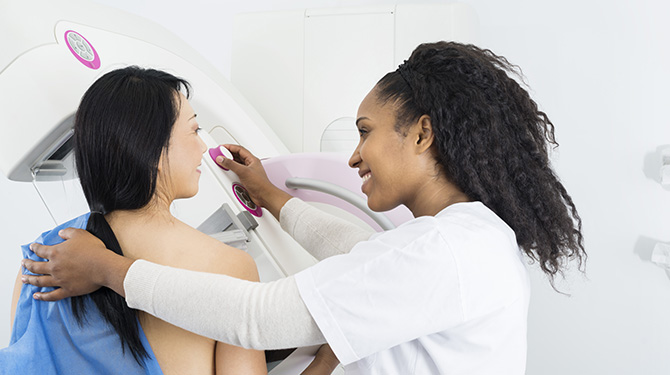 A mammogram is a special x-ray of the breast.
A mammogram is a special x-ray of the breast.
Mammography can detect lumps and other forms of breast disease, including breast cancer, that may be too small to be felt by an experienced examiner. This early detection is your best opportunity for a total cure.
X-ray equipment dedicated exclusively to performing mammograms is used. This allows us to use x-ray levels that are three to nine times lower than normal x-ray levels.
Digital mammograms are available at all Catholic Health sites.
Three-dimensional (3-D) mammography (digital breast tomosynthesis, or DBT) is available at the Center for Women at Mount St. Mary’s Hospital, Mercy Comprehensive Care Center, Mercy Diagnostic & Treatment Center, and the Piver Center for Women’s Health & Wellness.
A mammogram can detect lumps and other forms of breast disease that may be too small to be felt by even an experienced health professional. Early detection of breast cancer provides the best opportunity for a complete recovery.
Digital mammography is one of the more recent advances in mammogram technology. The images are available immediately and can be digitally enhanced to improve the radiologist’s ability to interpret breast tissue. Digital mammography images are captured electronically and are able to be viewed on a computer screen.
Advantages of Digital Mammography Include:
Menstruation: If you are pre-menopausal, try to schedule your mammogram the week after your period, when your breasts will be the least sensitive. Avoid having your mammogram the week before your period.
Records: If you have mammography films or images from another hospital or clinic, contact their radiology records department and make arrangements to pick them up prior to your mammogram. You will need to bring these to your appointment.
Beverages: Avoid caffeinated beverages 48 hours prior to your exam, as caffeine could make your breasts more sensitive.
Do not wear deodorant or any other powders, perfumes or locations under your arms or breast area on the day of your appointment. Residues produced by these items could show up on and interfere with your images.
Wear comfortable clothing to your appointment. Because you will be asked to remove all of your clothes from the waist up, you may wish to dress in two pieces. Gowns will be available for you to wear prior to your exam.
Bring all previous mammography images to your appointment if you had them taken outside the Catholic Health network.
Once in the mammography room, a specially trained breast technologist will position one of your breasts on the mammogram unit. A plastic paddle will compress the breast. This compression is necessary to even out the breast tissue so that the entire breast is scanned and small tumors are not obscured by overlapping tissue.
The technologist will stand behind a glass plate and take the first breast image. She will then reposition you to take a side view of the same breast. The procedure will then be repeated with the other breast. If your breasts are very large, or if you have breast implants, extra images will be needed to make sure your exam is complete.
A radiologist will study the images and report the results to your physician. If you are called back for a follow-up, it only means that the radiologist needs more information. It does not automatically indicate that you have breast cancer. Most spots detected are benign.
We will bill your insurance company directly. Please bring your insurance card and referral/authorization form on the day of your exam.
Cancer Services Programs of Western New York (CSPWNY) provide free breast, cervical, and colon cancer screenings to uninsured women and men in all seven counties of Western New York. With enrollment in this program, free screenings, diagnostics, and treatment services are available at most Catholic Health sites. Please call CSPWNY to enroll.
Visit their website for more information.
Sometimes cancellations are unavoidable. Please notify us one day in advance whenever possible. This will assist the staff in scheduling other patients waiting for appointments.